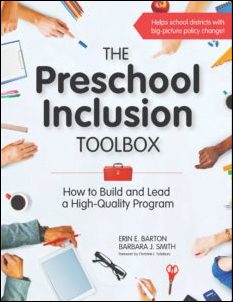The Impact of Inclusive Classrooms – Q&A with Erin Barton and Barbara Smith

We asked Erin Barton and Barbara Smith, authors of The Preschool Inclusion Toolbox, to talk a little bit about the benefits of inclusion in an early childhood learning environment.
Q: How can an inclusive early childhood classroom impact a child’s engagement and success in school?
A: There are three main reasons why inclusive classrooms impact a child’s engagement and academic success. First, research consistently demonstrates that responsive, engaging environments are associated with positive outcomes for young children, including for children with disabilities. However, a common finding across the research on preschool inclusion is that placement alone is not sufficient to facilitate learning and development. Successful placements for young children with and without disabilities requires that teachers plan for and embed a sufficient number of instructional opportunities across the day. Teachers in inclusive preschool classrooms organize the learning environment, uses systematic prompting and feedback, and systematically and intentionally design the environment to ensure each child receives multiple, meaningful instructional opportunities. Inclusive programs are particularly well suited to create environments in which all children are supported and included as engaged, participating members of their classrooms, early childhood programs, and communities.
Second, a foremost developmental task of preschoolers is to become an accepted member of a peer group and develop friendships. Children develop these relationships over time through a history of interactions with each other. Some children will need more intentional, systematic instruction to learn appropriate social skills. Peer social interactions should be supported to the extent that they occur at sufficient rates to promote the development of friendships for all children with and without disabilities. Inclusive classrooms are an ideal context for supporting friendships among children.
Third, inclusive preschools support their staff, which is critical for supporting child outcomes. Inclusive programs establish a structure and process for ongoing professional development and support collaborative teaming. Effective ongoing professional development and collaborative teaming are critical features of successful inclusive programs. These require support from administration, frequent opportunities for teams to meet including families, shared goals and instructional plans, and clearly identified roles and responsibilities, which in turn are related to improved outcomes for children.
Interested in Learning More?

The Preschool Inclusion Toolbox
You’ll learn how to overcome the challenges to a high-quality inclusive preschool program, and you’ll create a solid action plan for building and maintaining a successful program where all children learn and grow together. Check out the book »
Read a free excerpt from the book. What is quality inclusion? »
View the infographic. 7 key features of quality inclusion »
Watch the free webinar. How to Build and Lead a High Quality Preschool Inclusion Program »

